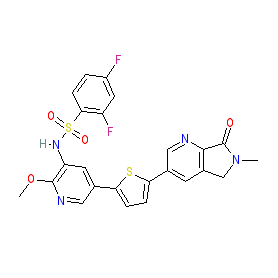|
Compound class:
Synthetic organic
Comment: Compound 16 inhibits the cytolytic pore-forming activity of the perforin 1 protein [2]. It has been developed to ascertain whether perforin inhibition can prevent early rejection of mismatched grafts in donor stem cell transplant procedures, and thereby improve successful engraftment. The acting hypothesis is based on the recognition that the natural killer (NK) cells that drive graft rejection overwhelmingly use perforin to kill non-self targets [1,3]. In addition, as these NK cells are resistant to radio- and immuno-suppression, an alternative mechanism is needed to limit their activity and to achieve clinical efficacy.
Ligand Activity Visualisation ChartsThese are box plot that provide a unique visualisation, summarising all the activity data for a ligand taken from ChEMBL and GtoPdb across multiple targets and species. Click on a plot to see the median, interquartile range, low and high data points. A value of zero indicates that no data are available. A separate chart is created for each target, and where possible the algorithm tries to merge ChEMBL and GtoPdb targets by matching them on name and UniProt accession, for each available species. However, please note that inconsistency in naming of targets may lead to data for the same target being reported across multiple charts. ✖ |
|
|||||||||||||||||||||||||||||||||||
| Bioactivity Comments |
| Compound 16 has favourable physicochemical and pharmacokinetics profiles [2]. In vivo, compound 16's perforin-inhibiting action prevents cytotoxic T cell/natural killer cell-mediated killing of transplanted bone marrow stem cells. |
| Selectivity at other protein targets | ||||||||||||||||||||||||||||||||||
| Key to terms and symbols | Click column headers to sort | |||||||||||||||||||||||||||||||||
|
||||||||||||||||||||||||||||||||||








